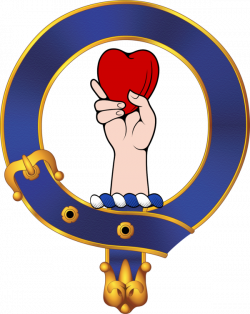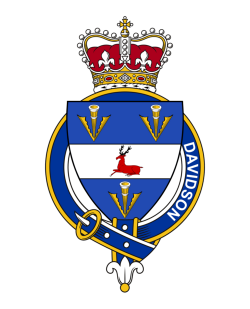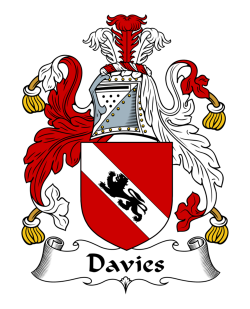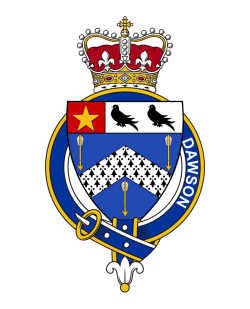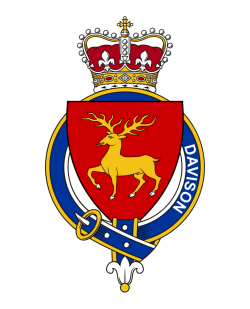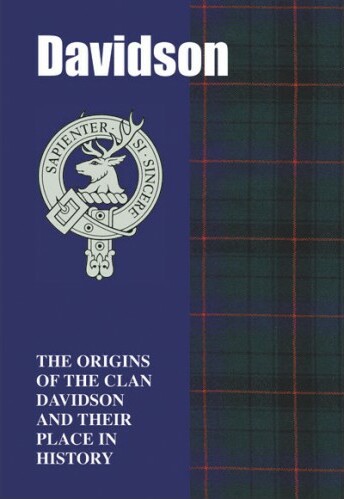
Clan Davidson
WISELY IF SINCERELY
The origins of clan Davidson are unclear. One theory speculates that they were one of the co-founders of the Chattan Confederation, and subsequently the clan are descended from the chief of Clan Chattan. Other accounts speculate that the "David" from whom the clan take their name is David Dubh of Clan Cumming.
After a battle with clan Cameron which saw their forces essentially wiped out, the Davidsons lived relatively peacefully for many years as part of the Chattan Confederation. They were involved in the Jacobite uprising of 1745, and after the Battle of Culloden many Davidsons were convicted of treason and exiled to North America.
Although the name Davidson was found across Scotland, the most prominent clan branches were the Davidsons of Cantray in Inverness-shire and the Davidsons of Tulloch in Easter Ross. After the death of Clan Davidson was without a clan chief for some eighty years until the last direct line of descent was established in the 1990s.
The Davidson clan motto is Sapienter si sincere (Wisely if sincerely) and the clan crest is a stag's head.
The Tartans
of Clan Davidson
Scottish History
of Davies Family
Slaughter and destruction
The Davidsons are one of the principal branch clans which formed the mighty Clan Chattan, the Clan of the Cat. Their patronymic is Mhic Daibhidh, or MacDaidh, son of David, for they descend from David Dhu, the fourth son of Muirich, the Celtic hereditary lay prior or parson of Kingussie who was 4th Chief of Clan Chattan in the 13th century. The second son was Ewen whose patronymic was Mhic Phearsain, son of the parson. In later years the Davidsons and the MacPhersons became dire enemies despite, or perhaps because of, their close relationship. The Davidson lands were at Invernahaven near Kingussie in Badenoch, where the rivers Truim and Spey meet, adjacent to the lands of the MacPhersons.
Both clans belong to the Clan Chattan, the Clan of the Cat, a confederation of clans who claimed their progenitor was Gillie Chattan Mor who was 1st Chief of Clan Chattan in the 11th century. The original lands of the old Clan Chattan were in Lochaber with the chief’s castle being at Torcastle. Gillie Chattan Mor The Servant of St Catan, was descended from the Royal House of Lorn. St Catan’s name means Little Cat, perhaps an affectionate pun for a revered churchman, but the heraldic beast of the Clan Chattan became a snarling wildcat with the motto “Touch not the Cat Without a Glove”.
Eva, heiress of Clan Chattan, and granddaughter of Muirich the Parson, married 23-year-old Angus, 6th chief of the Mackintoshes in 1291, and brought the chieftainship and lands of Clan Chattan to him.
An old manuscript says the marriage came about because Alexander MacDonald, Lord of the Isles, sent his nephew Angus Mackintosh, chief of the Mackintoshes, to Dugall Dall Macgilliechattan, Chief of Clan Chattan, to inform him that the Lord of the Isles would pay him a visit.
Apparently it was the custom that the Lord of the Isles required to be provided with either the host’s wife or daughter as a companion for the night when he came to visit. Macgilliechattan, to avoid this, managed to hastily marry his daughter Eva to Angus Mackintosh when he brought the message, and thus Angus became paramount Chief of Clan Chattan.
The centre of power of Clan Chattan now moved to the Mackintosh lands in Badenoch and there was a migration of clanspeople into the area from which Bruce had recently removed the Comyn family. Angus Mackintosh then rented out the extensive Clan Chattan lands in Lochaber and west Badenoch to the Camerons. However, no sooner had they taken possession than they refused to pay the stipulated rent. The Camerons then claimed the land by right of the sword, and this led to numerous minor conflicts over the next century.
The Mackintosh chiefs usually solved the matter by raiding the Cameron lands and taking cattle in lieu of money. Finally, the Camerons had had enough. They marched into Badenoch in 1375 with a huge force and stripped it bare with terrible slaughter. They were stopped at the Davidson lands of Invernahaven by Lachlan Mackintosh, 8th Chief of Clan Chattan, who had hurried south with some of his own men to take command of a force comprised of MacPhersons and Davidsons.
The two armies met at the junction of the rivers Truim and Spey south of Kingussie. The Mackintosh ordered the combined clans forward but a bitter argument broke out between the other two chiefs as to which should have the honour of commanding the right wing of Clan Chattan.
Cluny MacPherson claimed the right as senior representative on the male side of the older Clan Chattan, and Davidson said it was his as the oldest cadet family. The exasperated Mackintosh chose the Davidsons, and urged them both on. The MacPhersons, considering themselves grossly insulted, then left the field of battle and waded across the Spey. They sat on the little birch covered knoll to the north of the river junction and ate their midday meal watching the battle purely as disinterested spectators. They saw MacDaidh, the Davidson Chief, and his seven sons, killed within two hundred yards of their own house; they saw the Mackintosh line begin to waver amidst the clash of claymore on targe; they heard the whistle of arrows and the screams of dying men. But they still did not move.
Lachlan Mackintosh realised Clan Chattan was losing badly and resorted to a subterfuge. He told his bard to take a circuitous route to make it appear he had come from the Camerons, and pretend to be one of them. He was to compose and recite to the MacPhersons a satirical poem accusing them of cowardice. The office of bard was a sacred one which enabled the holder to travel freely between enemies and deliver his message without harm. Thus no one took any notice of the bard as he made his way through the two forces to the little island where the MacPhersons sat.
Pretending to come from the Camerons, the bard burst into recitation. His ballad, roughly translated, said “the false party are on the hillock, and the man with the big brown eyes (the Mackintosh) is in distress. It was not out of friendship to us, but merely your own cowardice that made you sit and watch”.
The MacPhersons were enraged at supposedly being so taunted by the victor of the fight and followed the Camerons back up into the mountains. Here they fell upon them with dreadful slaughter, and killed their chief Charles Macalonair at a hollow in the hills beside Loch Pataig, henceforth known as Coire Thearlaich, Charlie’s Cauldron.
Prophecies and personalities
Later the name almost vanishes from Badenoch, being replaced by the names of MacPhersons and Mackintoshes. A manuscript by Lachlan Shaw says the Invernahaven family changed their name to MacPherson by decision of their chief Seumas Laggach. An alternative account suggests that in 1524 Milmoir MacDaidh murdered Lachlan, 14th Chief of the Mackintoshes, who had ruined his hopes of marrying a rich widow.
For this crime he and another Davidson were held prisoner in Loch an Eilean castle for seven years without trial, then tortured, hanged and beheaded. Perhaps it was the shame of this that lead the Davidsons to assume the name of their closest kin as they too were “sons of the parson”.
There is certainly no mention of them in the list of broken clans of “the hail kin of Clann Cattan” compiled in the mid 16th century. Nor are they found in the list of those attending the great gathering of Clan Chattan at Termitt in Petty near Inverness in 1606, although the old records do state there were others of Clan Muirich from Badenoch as well as “Cluny MacFersone”.
However, it appears possible that a survivor of the chief’s family, and a few followers, left Speyside and made their way to the north east. The next firm record is of Donald Davidson who acquired land at Davidston near Cromarty around the middle of the 17th century. He claimed descent from an ancestor who had entered the service of the King of France and was recorded in 1629 in the “Livre d’Or” as one who could trace noble birth through six generations.
His son became town clerk of the county while his grandson William married in 1719 the daughter of the Bayne laird who owned the estate of Tulloch at Dingwall. Their son Henry Davidson, born in 1729, made his way to London and amassed a fortune in the West Indies trade. He returned north in 1763 and bought Tulloch for £10,500 from his Bayne in-laws, and this became the seat of the Davidson chiefs from then on.
By virtue of this ownership they also became Keepers of the Royal Castle of Dingwall, although by this time it was pretty ruinous. His brother Duncan, a lawyer, succeeded him in 1781 and made great improvements to the estate. He also built the main road north from Dingwall and reclaimed land from the sea. He was a member of Parliament for Cromarty from 1790 to 1796. His son Henry, another prosperous West Indies merchant, succeeded him and also carried out tree plantings and improvements
Family History Mini Book
We hope you enjoyed reading this excerpt from this mini book on the Scottish history of the Davidson family.
You can buy the full book for onlyEnglish History
of Davies Family
Of royal pedigree
A name of ancient roots, ‘Davies’ is ranked at number six in some lists of the 100 most common surnames found in England, but it is in Wales that it is particularly prevalent.
Spelling variations of the name include ‘Davis’, ranked at number 56 in some lists of the most common surnames, and whose bearers today have their own separate and proud history.
Derived from the popular personal name of David, the Davies name is of Biblical roots, with ‘David’ meaning ‘beloved’ and also the name of the Old Testament David, founder of the Jewish Royal House of David.
The name also became popularised in medieval times, particularly in Wales, through veneration for David, the mid to late sixth century Welsh bishop who was later canonised as a saint and adopted as the patron saint of Wales.
With a white dove as his emblem, he was a renowned preacher and teacher and founded a number of churches and monastic settlements that include what is now St David’s Cathedral, in Pembrokeshire, on the site of one of the monasteries he founded.
While many bearers of common surnames found in both England and Wales today are of Anglo-Saxon roots, bearers of the Davies name are of even earlier Brythonic, or British, origin.
Of Celtic pedigree, these early inhabitants of the British Isles were settled for centuries from a line south of the River Forth in Scotland all the way down to the south coast of England and with a particular presence in Wales.
Speaking a Celtic language known as Brythonic, they boasted a glorious culture that flourished even after the Roman invasion of Britain in 43 AD and the subsequent consolidation of Roman power by about 84 AD.
With many of the original Britons absorbing aspects of Roman culture, they became ‘Romano-British’ – while still retaining their own proud Celtic heritage.
In a much later century, Edward Davies, born in 1756 in Llanfaredd, Radnorshire, and known as Edward “Celtic” Davies, played an important role in the study of Celtic languages and mythology.
An Anglican clergyman, before his death in 1831 he wrote a number of scholarly books that include his magisterial 1804 Celtic Researches on the Origin, Traditions and Languages of the Ancient Britons and his 1809 The Mythology and Rites of the British Druids.
Going back in time, the death knell of the native Britons was sounded when Germanic tribes invaded and settled in the south and east of the island of Britain from about the early fifth century.
Known as the Anglo-Saxons, they were composed of the Jutes, from the area of the Jutland Peninsula in modern Denmark, the Saxons from Lower Saxony, in modern Germany and the Angles from the Angeln area of Germany.
It was the Angles who gave the name ‘Engla land’, or ‘Aengla land’ – better known as ‘England.’
They held sway in what became England from approximately 550 until 1066, with the main kingdoms those of Sussex, Wessex, Northumbria, Mercia, Kent, East Anglia and Essex.
It was only in Cornwall, Wales, parts of the north of England and eastern Galloway in Scotland where the Brythonic culture retained a tenacious foothold – with these indigenous Britons referring to the Anglo-Saxons as ‘Saeson’ or ‘Saxones.’
It is from this that the Scottish Gaelic term for ‘English people’ of ‘Sasannach’ derives, the Irish Gaelic ‘Sasanach’ and the Welsh ‘Saeson.’
The first serious shock to Anglo-Saxon control of England came in 789 in the form of sinister black-sailed Viking ships that appeared over the horizon off the island monastery of Lindisfarne, in the northeast of the country.
Lindisfarne was sacked in an orgy of violence and plunder, setting the scene for what would be many more terrifying raids on the coastline of not only England, but also Ireland and Scotland.
But the Vikings, or ‘Northmen’, in common with the Anglo-Saxons of earlier times, were raiders who eventually stayed – establishing, for example, what became Jorvik, or York, and the trading port of Dublin, in Ireland.
Through intermarriage, the bloodlines of the Anglo-Saxons and the indigenous Britons such as those who would come to bear the Davies name also became infused with that of the Vikings.
But there would be another infusion of the blood of the ‘Northmen’ in the wake of the Norman Conquest of 1066 – a key event in English history that ended Anglo-Saxon supremacy.
By 1066, England had become a nation with several powerful competitors to the throne.
In what were extremely complex family, political and military machinations, the English monarch was Harold II, who had succeeded to the throne following the death of Edward the Confessor.
But his right to the throne was contested by two powerful competitors – his brother-in-law King Harold Hardrada of Norway, in alliance with Tostig, Harold II’s brother, and Duke William II of Normandy.
In what has become known as The Year of Three Battles, Hardrada invaded England and gained victory over the English king on September 20 at the battle of Fulford, in Yorkshire.
Five days later, however, Harold II decisively defeated his brother-in-law and brother at the battle of Stamford Bridge.
But he had little time to celebrate his victory, having to immediately march south from Yorkshire to encounter a mighty invasion force led by Duke William of Normandy that had landed at Hastings, in East Sussex.
Harold’s battle-hardened but exhausted force confronted the Normans on October 14 in a battle subsequently depicted on the Bayeux Tapestry – a 23ft. long strip of embroidered linen thought to have been commissioned eleven years after the event by the Norman Odo of Bayeux.
Harold drew up a strong defensive position at the top of Senlac Hill, building a shield wall to repel Duke William’s cavalry and infantry.
The Normans suffered heavy losses, but through a combination of the deadly skill of their archers and the ferocious determination of their cavalry they eventually won the day.
Anglo-Saxon morale had collapsed on the battlefield as word spread through the ranks that Harold had been killed – the Bayeux Tapestry depicting this as having happened when the English king was struck by an arrow to the head.
Amidst the carnage of the battlefield, it was difficult to identify Harold – the last of the Anglo-Saxon kings.
Some sources assert William ordered his body to be thrown into the sea, while others state it was secretly buried at Waltham Abbey.
What is known with certainty, however, is that William in celebration of his great victory founded Battle Abbey, near the site of the battle, ordering that the altar be sited on the spot where Harold was believed to have fallen.
William was declared King of England on December 25, and the complete subjugation of newly conquered subjects followed.
Within an astonishingly short space of time, Norman manners, customs and law were imposed on England – laying the basis for what subsequently became established ‘English’ custom and practice.
But beneath the surface, both old Anglo-Saxon and Brythonic culture was not totally eradicated.
Some aspects were absorbed into those of the Normans, while faint echoes of the Brythonic past is still seen today in the form of popular surnames such as Davies.
Battle honours
The Davies name is first found in Flintshire, while many of its bearers have stamped a significant mark on the historical record.
In Wales, some of the name today can claim a descent from a royal prince.
This is through the late twelfth century Cynrig Efell, Lord of Eglwsegle, a twin son of Madog ap Maredudd, the last prince of the Welsh kingdom of Powys, and who died in 1160.
Of Madog – whose name is sometimes also rendered as ‘Madoc’ – the ancient Welsh annals relate how:
While Madog lived there was no man
Dared ravage his fair borders
Yet nought of all he held
Esteemed he his save by God’s might
Another ancestor of those who would adopt the Davies surname from the forename of David was Dafydd ap Gruffyd – David, son of Gruffyd – the royal prince who was the last independent ruler of Wales.
It was in January of 1283, after England’s ambitious Plantagenet king Edward I surrounded what then remained of independent Wales with a ring of steel in the form of a massive army, that Daffydd ap Gruffyd launched an armed resistance movement.
In the same mould as Scotland’s great freedom fighter William Wallace, he achieved a number of daring successes before eventually being captured in May of that year.
On the orders of Edward, he was subjected to the brutal ordeal of being dragged through the streets of Shrewsbury attached to a horse’s tail and then hanged, drawn and quartered.
Continuing a Davies tradition of resistance to arbitrary power and rule, David Davies, born in 1812 and known in Welsh as Dai’r Canwr – David the Singer – was the farm labourer, lay preacher and poet who was sentenced to transportation to Van Diemen’s Land, now modern-day Tasmania, for his part in the Rebecca Riots.
Taking place between 1839 and 1843 in South and Mid Wales, these riots involved farmers and other agricultural workers protesting over what they perceived as unjust taxation.
Often dressed as women to hide their identities – hence the term ‘Rebecca’ Riots – they carried out attacks on toll-booths and turnpikes.
In December of 1843, Davies was tried and convicted for his part in demolishing a turnpike at Spudder’s Bridge, near Kidwelly.
Pardoned in October of 1854, he returned from Van Diemen’s Land to his native Wales, where he died in a fire in 1874; there is a statue to him outside the Barry Dock Offices in Barry, Vale of Glamorgan.
On rather more conventional fields of conflict, no fewer than three bearers of the proud name of Davies were recipients during the First World War of the Victoria Cross (VC), the highest award for valour in the face of enemy action for British and Commonwealth forces.
Born in 1886 in the Ogmore Vale, Glamorgan, James Davies had been a corporal in the 13th Battalion, The Royal Welch Fusiliers when, in July of 1917 at Polygon Wood, Pilkem, in Belgium, he performed the actions for which he was posthumously awarded the honour.
During an assault on the enemy’s line, he single-handedly attacked a machine-gun emplacement and overcame its crew. Although wounded, he then led a bombing party on a successful assault on another enemy position.
He died later from wounds received, while his VC is now on display at the Royal Welch Fusiliers Museum, Caernarfon Castle.
Born in 1895 in Birkenhead, Cheshire, John Davies was a corporal in the 11th (Service) Battalion, South Lancashire Regiment.
In March of 1918 near Eppeville, France, he mounted a parapet in full view of the enemy and unleashed a storm of machine-gun fire that allowed his comrades to successfully withdraw to another position.
Taken prisoner after the action, he went on to serve in the Home Guard during the Second World War; he died in 1955, while his VC is now on display at the Imperial War Museum, London.
Both a fighter pilot and a Royal Navy officer, Richard Bell Davies won his VC after carrying out what is considered to have been the first ever combat search and rescue by aircraft.
Born in 1886 in Kensington, London, he was a Squadron Commander in 3 Squadron, Royal Naval Air Service, when in November of 1915 he carried out the action for which he was awarded the honour.
This was when, at Ferrijik Junction, in Bulgaria, he managed against all the odds to land his aircraft in enemy territory and take-off again with a fellow pilot who had crash landed.
Later promoted to the rank of Vice-Admiral, he died in 1966, while his VC is now on display at the Fleet Air Arm Museum in Yeovil, Somerset.
Born in 1913 in Bernardsville, New Jersey, James Davies, better known as Jimmy Davies, was the first American-born airman to be killed in action during the Second World War.
Having moved with his family to their original homeland of Wales before the outbreak of the war in 1939, he joined the Royal Air Force.
Flying the Hawker Hurricane fighter with 79 Squadron, based at RAF Biggin Hill, he was shot down and killed in June of 1940 while on a mission over the French port of St Valery.
His death came on the same day he was due to be presented by King George V with the Distinguished Flying Cross (DFC) for having previously shot down six German aircraft.
In the world of politics, David John Denzil Davies, better known as Denzil Davies, is the British former Labour Party politician born in 1938 in Cynwyl Elfed, Carmarthenshire.
Qualifying as a barrister, he later served for 35 years as Member of Parliament (MP) for Llanelli, while he served as a Treasury Minister in the late 1970s in the government of Prime Minister James Callaghan.
Born in 1939, Bryan Davies is the British Labour Party politician who was elevated to the Peerage of the United Kingdom as Baron Davies of Oldham, of Broxbourne in the County of Herefordshire, in 1997.
Serving as Secretary to the Parliamentary Labour Party and Shadow Cabinet from 1979 until 1992, he also served from 1977 to 1979 as a member of the Medical Research Council.
Not only a Liberal Party politician but also a prominent nineteenth century Welsh entrepreneur, David Davies was born in 1818 in Llandinam, Montgomeryshire.
Mainly self-taught, he went on to become a coal magnate and was responsible for much of the industrialisation of the Rhondda Valley.
Liberal MP for Cardigan Boroughs from 1874 to 1885 and later for Cardiganshire and also responsible for building the first iron bridge in Montgomeryshire, he died in 1890.
He was the grandfather of the politician and philanthropist David Davies, born in Llandinam in 1880.
Liberal MP for Montgomeryshire from 1906 to 1929 and a leading supporter of the League of Nations that was set up in the aftermath of the First World War, he was also the founder in 1932 of the New Commonwealth Society “for the promotion of international peace and order.”
Created 1st Baron Davis, before his death in 1944 he endowed the Chair in International Politics at the University of Wales, Aberystwyth that is also home to the David Davies Memorial Institute of International Studies.
Family History Mini Book
We hope you enjoyed reading this excerpt from this mini book on the English history of the Davidson family.
You can buy the full book for only117 Clan Davidson
Tartan Products
The Crests
of Clan Davidson

